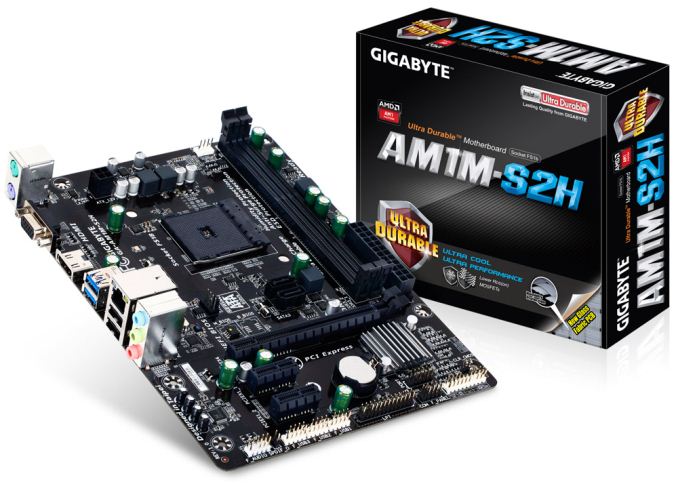GIGABYTE AM1M-S2H Review: What Can $35 Get You?
by Ian Cutress on August 15, 2014 3:00 PM EST- Posted in
- Motherboards
- AMD
- Gigabyte
- Kabini
- AM1
GIGABYTE AM1M-S2H Conclusion
Low cost, low power motherboards are difficult to conclude. With high end motherboards containing controllers and where we discuss performance, it is easy to rule out $20 of controller improvements for a better overclocking range. But when the whole motherboard is $35, and the motherboard/CPU/DRAM combo for $120 or so, it all comes down to the market.
If we imagine a digital signage seller, in the prototype stage they will buy a set of units in order to design the system. Because the motherboards are cheap, if they accidentally get the wrong one, then buying another is relatively trivial. The same goes for replacement parts: rather than take the time to RMA, it becomes cheaper just to bin and replace where necessary.
The biggest issue for this type of environment for the AM1M-S2H is the position of the SATA ports. Because they are both right in the middle of the motherboard, SATA cables for the hard-drive and ODD have to reach over components to get there. The only way to mitigate this would be to boot from USB, which is not uncommon for digital signage, but what would make that setup better is an onboard USB port akin to some server designs.
In actual fact, I wonder if having an onboard microSD card reader might be more pertinent for this type of platform. Rather than using a bulky SATA device, or relying on a USB that sticks out, how about an onboard microSD card reader that you can install an OS and boot from for the signage. Although the barrier to this, as always, is cost of implementation.
For users looking to build a daily system, without an add-in card you will have to decide between two HDDs or a HDD/ODD combination. The full-length PCIe slot helps if you want to add in more screens or a full-size GPU, although the CPU performance might be the main barrier to doing anything more than web browsing and word processing. One might argue that for GPU compute work, such as some video conversion or rendering, if it can be offloaded onto the GPU effectively with little CPU involvement then it might be worth a shot.
As a motherboard, it worked in our testing and the results are in-line with what we would expect for $35, if not slightly more impressive than we presumed. There are some style changes that I would put forward, especially the SATA port positioning. Unfortunately users have to put up with the older style software. It might help GIGABYTE in the future to develop some base fan control software for any platform to replace EasyTune 6, which might get bundled with the next generation of AM1 (if there is going to be another).











45 Comments
View All Comments
FriendlyUser - Sunday, August 17, 2014 - link
I can think of many, many friends who would be perfectly happy using this kind of system for everyday tasks. This is truly "good enough" computing.Arbie - Monday, August 18, 2014 - link
Ian's comment on "unreality" resonates with me. In fact I'd feel bad paying only $35 for a motherboard. Just to think what is involved in producing such a thing makes my head spin. The people doing it deserve more than they are getting from this. Even $100 is cheap. Approaching $200 brings it more in line with my personal reality, though it's still pretty amazing - and you get one heck of a board for that.It is somehow wonderful that the world can have $35 mobos and the low-cost PCs built on them. I just don't look there.
fanofanand - Tuesday, August 19, 2014 - link
Must be nice living in your world. This guy helps out those less fortunate and all you can do is brag about how you would just throw it in the garbage? You sir, suck at life.fanofanand - Tuesday, August 19, 2014 - link
That was supposed to be a reply to the dude trashing HardwareDufus, not sure how it landed at the end....either way, I think it's fantastic that he helps out those less fortunate with your "trash"jabber - Wednesday, August 20, 2014 - link
Well what do you do with tech junk when no one wants it? This is my job, not a hobby. I have a wife, that means you cant hoard stuff. I live in the first world, people don't want it any more. A friend of mine sells old Dell single core PCs. He sells 10 of them for like $90 on a pallet and no one wants them. It's junk.I'll say it again...junk.
Plus if you give old slow computers to people...they expect you to support it. I have a life.
Quit being so dippy and sentimental and get with stark modern reality. It's just some crappy 12 year old CPUs and PCs. Not like I'm throwing food in the trash in front of staving kids.